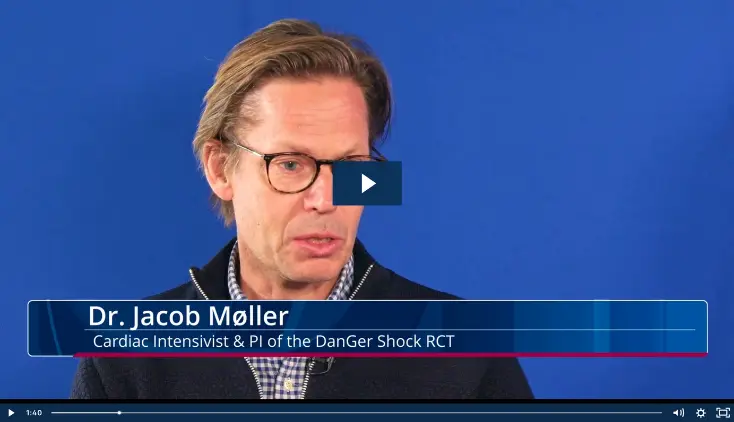Clinical Research & Data, AMI Cardiogenic Shock
DanGer Shock Results from Dr. Jacob Møller at ACC 2024
Jacob Møller, MD, the principal investigator of the DanGer Shock RCT, discusses study results he presented at the 2024 American College of Cardiology (ACC) Scientific Session in this interview with Chuck Simonton, MD, Abiomed's Chief Medical Officer.
Dr. Møller explains that DanGer Shock was designed for patients with predominantly left ventricular (LV) failure and acute myocardial infarction (AMI) cardiogenic shock. Inclusion criteria included ST-elevation myocardial infarction (STEMI), hypotension and hypoperfusion as indicated by elevated lactate levels, left ventricular ejection fraction (LVEF) <45%, and randomization at the time that shock was diagnosed. Patients were excluded if they remained comatose after out-of-hospital cardiac arrest (OHCA) or had right ventricular failure or mechanical complications.
Patients were randomized at the time that cardiogenic shock was diagnosed to either receive Impella CP or to PCI with potential escalation to MCS other than Impella. Patients were followed for 180 days, the primary endpoint observed being all cause mortality.
“We ended up with a very sick population,” Dr. Møller explains, highlighting that the median age of the patients was 67 years and these patients had median lactate levels of 4.5 mmol/L, median LVEF of 25%, and median systolic blood pressure of 82 mmHg. Seventy two percent of patients had LAD or LM culprit and multivessel disease, 55% were SCAI shock class C, and 45% were SCAI class D or E.
“For the primary endpoint we saw an absolute reduction in all-cause mortality of 13%,” Dr. Møller reports. Mortality rate was almost 59% in the control group and 46% in the group treated with Impella CP. While those rates are still high, Dr. Møller calls the 13% reduction “quite remarkable” and notes that the curves kept separating.
“So here we have the sickest of the sickest, I would say, and they clearly benefited,” Dr. Møller emphasizes. “But we also saw that putting such a device into a patient comes with a risk of complications.” These complications were expected, Dr. Møller explains, and not a surprise.
Dr. Simonton describes DanGer Shock as “the first study in the history of our field, in STEMI-related cardiogenic shock, where a mechanical circulatory device has shown a reduction in mortality.” He asks Dr. Møller what it is that Impella is doing, in terms of the way it unloads the heart, that may have led to these outcomes. “I think that the fact that the Impella lowers wall stress and it lowers filling pressure,” Dr. Møller replies, “I think that’s a key for the heart to recover.”
Dr. Møller also states that patient selection was key to the results of this trial. “We managed to select the patients that are truly hypoperfused because the heart can’t pump enough blood,” he explains, “So I think that’s the key. And then the Impella goes in and it does the job here.”
Dr. Simonton and Dr. Møller also discuss the risk/benefit balance in these patients. Dr. Møller highlights the importance of training in the ICU to reduce complications after patients leave the cath lab. “I think that’s the key to improving this, and I’m sure we can do better.”
Sign Up for Latest Updates
IMP-5182


